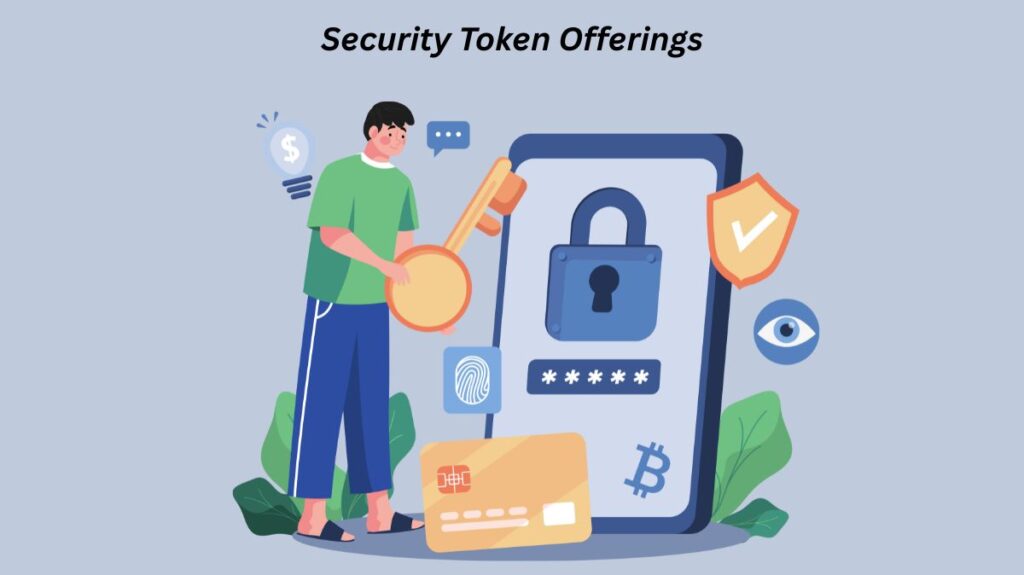Security Token Offering Platform
One kind of token offering is Security Token Offerings (STOs), in which tokenized assets are exchanged on cryptocurrency exchanges. Compared to some other token sales, especially Initial Coin Offering (ICOs), they offer a more secure and regulated method of raising money.

This is a thorough description of STOs:
Core Concept and Nature of STO
- Tokenized Securities: Any financial asset, including securities and commodities, can be represented by security tokens, which are available in STOs. These externally traded assets are the source of their worth. Shares in a firm are one example.
- Origin in Digital: Security tokens exist digitally on a blockchain, as opposed to conventional securities, which might be stored in a bank register. This makes it possible to transform ownership rights of a physical item into a digital or cryptographic token.
- Equity/Ownership: Security tokens frequently give holders equity in the form of ownership or dividend payments, much like traditional stocks do. An important motivator for investors is the possibility of value growth.
Regulatory Framework and Compliance
- Classification as Securities: The fact that the tokens sold by STOs are categorized as securities is one of their primary differentiators. In contrast to ICOs, which are frequently uncontrolled, this indicates that they are more secure and subject to regulation.
- Legal Governance: Due to their classification as securities, STOs are subject to all conventional securities laws and regulations. EU requirements like MiFID II must be followed. The US SEC reviews all coins, ICOs, and digital assets securities. The SEC’s FinHub innovation section evaluates financial technologies like blockchain and has issued digital asset investment contract standards.
- KYC/AML: According to the sources, in order to address money laundering concerns in the larger token ecosystem, official Know Your Customer (KYC) and Anti-Money Laundering (AML) regulations are being suggested. A built-in KYC procedure in certain private permissioned DLTs (Distributed Ledger Technologies) only allows parties to be added following extensive background checks.
- Increased Confidence: STO regulation contributes to a rise in consumer confidence and system trust.
Benefits of Security Token Offering
- Efficiency and Transparency: Security tokens are thought to be a more effective, scalable, and transparent alternative to conventional techniques because of their partially decentralized nature, which eliminates the need for a middleman. On a blockchain, every action is publicly viewable and easily auditable.
- Faster Processing: In contrast to conventional financial systems, they provide quicker processing times.
- Fractional Ownership: STOs make it possible for multiple investors to hold a portion of an asset, which is frequently difficult to do legally and practically in conventional situations.
- Liquidity: By enabling tokenization and trading on an exchange with fractional ownership, tokenization including security tokens can increase the liquidity of assets that are often illiquid, such as paintings and real estate.
Process of Tokenization for STOs
A general procedure for tokenizing an asset or providing a security token is described, even though the sources do not contain comprehensive technical details:
- Investor Onboarding: An investor has been onboarded who wants to tokenise their asset.
- Asset Scrutiny and Ownership Confirmation: The suggested tokenized asset is examined, audited, and its ownership verified. Usually, the company providing the tokenized security (such as an exchange or cryptocurrency firm) does this.
- Initiation of STO Process: The STO is the result of the tokenised security procedure.
- Physical Asset Custody: In the actual world, the tangible asset is entrusted to a custodian for protection.
- Token Creation and Issuance: The offering organization creates the derivative token, which is distributed to investors via a blockchain and represents the asset.
- Secondary Market Trading: In a secondary market, traders use trading exchanges to buy and sell these tokens, and the transactions are recorded on a blockchain.
Comparison with other Token Offerings
STO Vs. ICOs: ICOs provide utility tokens, are frequently unregulated, and typically accept donations in the form of pre-existing cryptocurrencies. The ICO itself introduces the new token. STOs, on the other hand, offer investors a more secure and regulated environment, are for tokenized securities, and are regulated. Scams and inadequate governance have exposed initial coin offerings (ICOs), prompting increased scrutiny and regulatory suggestions.
STO Vs. IPOs: Initial Public Offerings (IPOs) and STOs are compared. An STO is referred to as a tokenized initial public offering (IPO) if it is offered on a conventional stock exchange. IPOs are conventional, regulated methods of issuing company shares to the general public through underwriters. ICOs are characterized as a hybrid of an IPO and a kick-starter model, however they frequently lack the IPO’s regulation and kick-starter’s proof-of-concept.
STO Vs. ETOs: An alternative to ICOs and STOs are Equity Token Offerings (ETOs). ETOs offer shares of a corporation as tokens, whereas STOs offer shares in any asset. According to this viewpoint, ETOs are a particular kind of STO.
STO Vs. IEOs: In contrast to initial coin offerings (ICOs), initial exchange offerings (IEOs) make tokens available through an exchange, which increases transparency and credibility because of the exchange’s participation and due diligence.
Examples of STO
Supporting Platforms: Tokens can be created on any blockchain that has smart contract capability, which makes them appropriate venues for STOs. Ethereum and EOS are popular tokenization platforms. Because it supports smart contracts, Tezos is also becoming more popular.
Examples: One example given is the 2021 SEC-qualified Reg A+ token sale that was carried out by the Bitcoin wallet startup Exodus, which sold common shares that had been converted to Algorand tokens. Being the first digital asset security to offer equity in a US-based issuing company, this was recognized as a historic event.
By applying established regulatory frameworks to tokenized assets, STOs essentially represent a maturing of the digital asset industry with the goal of bridging the gap between blockchain technology and traditional finance.
